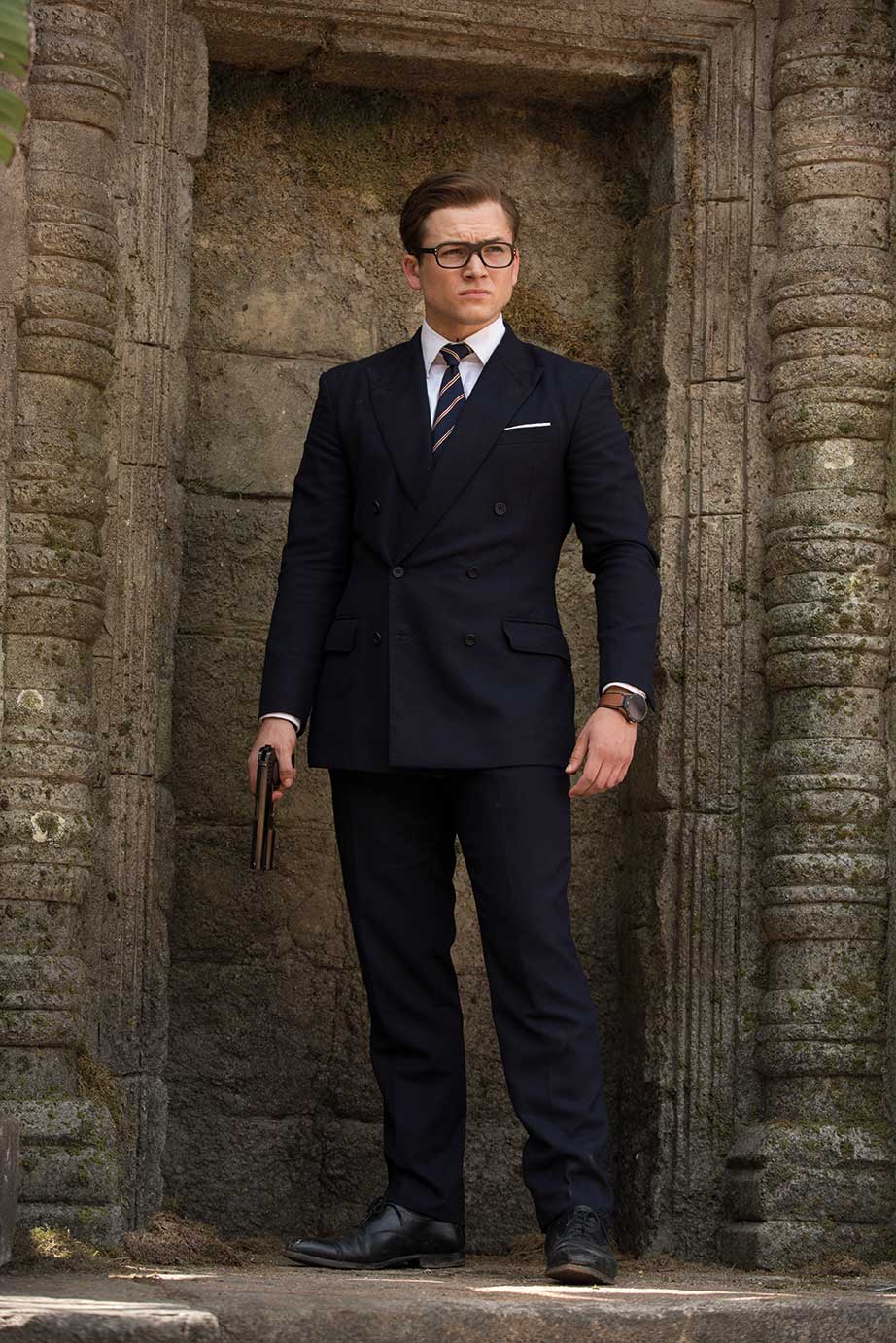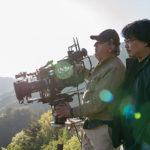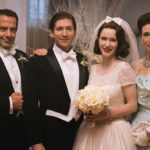
The King Makers
Posted on Oct 4, 2017 by Julian Mitchell
 The main camera used in Kingsman: The Golden Circle was an ARRI ALEXA Studio with internal CODEX recorder capturing in ARRIRAW format to CODEX media.
The main camera used in Kingsman: The Golden Circle was an ARRI ALEXA Studio with internal CODEX recorder capturing in ARRIRAW format to CODEX media.
Matthew Vaughn’s answer to the spy comedy genre just got bigger and better. We talk to the team behind Kingsman: The Golden Circle to learn more
It’s fitting that the origins of the Kingsman films can be traced back to a scenario lifted straight from the first line of a joke: two men walk into a bar. The two men were director Matthew Vaughn and writer Mark Millar, and together, they agreed that the spy genre had become too serious, and that it needed a new offering that was a bit more fun.
The result was 2015’s Kingsman: The Secret Service – a feature directed by Vaughn, based on a comic book co-written by Millar – filled with enough comedy, violence, and satirical nods to classic spy movies to keep an audience entertained the whole way through. Despite its relatively modest budget, The Secret Service won Best British Film at the Empire Awards that year. This year marks the return of London’s gentleman spy agency through its sequel – Kingsman: The Golden Circle.
Along with stars like Colin Firth and Taron Egerton, returning to the Kingsman world is much of the crew that made the first film such a success behind the scenes. There’s Vaughn, who returned to direct and co-write the script, along with DOP George Richmond, DIT Joshua Callis-Smith and Goldcrest Post colourist, Rob Pizzey. With everything from a large number of VFX set pieces to multiple HDR deliverables to consider, Rob used DaVinci Resolve Studio to maintain the same slick, rich overall aesthetic as the first film, while also ensuring they gave the sequel its own unique look.
As initial planning got underway for Kingsman: The Golden Circle, Matthew Vaughn and cinematographer George Richmond wanted to echo the memorably rectilinear visual style the duo crafted for 2014’s The Secret Service, while adding a sense of magnitude called for in the story. The Golden Circle takes the quintessentially British protagonists to America to team with US counterparts endowed with similarly exaggerated traits. Action is precisely choreographed, and stylish in the extreme, which somehow modulates the violence.
“It was very much in Matthew’s mind, even before we had the script, that the American side of this story was going to be bigger and better, at least in the minds of the American characters,” says George. “Bigger planes, bigger sets, bigger infrastructure. We scaled up, beginning with the art department, where production designer Darren Gilford brought that American flavour.”
Matthew’s predilection for vanishing lines converging at the centre of the frame, especially in wide shots, factored in the design and the photography. This time around, the images have greater contrast and more saturated colours, in tune with the “more of everything” aesthetic.
The Makers
 From the set of the film with Director Matthew Vaughn and actor Taron Egerton.
From the set of the film with Director Matthew Vaughn and actor Taron Egerton.
“It was great to be working with the same team again, especially since The Golden Circle was a much larger proposition, and with a much bigger budget than The Secret Service,” says colourist Rob Pizzey. “The film stars Colin Firth, Julianne Moore, Taron Egerton, Halle Berry, Channing Tatum, Jeff Bridges and even Elton John. It’s also shot in multiple locations, as the plot involves the agents of Kingsman heading to the US to join forces with Statesman, Kingsman’s American counterpart. The villain of The Golden Circle, Poppy Adams, also lives in an amazing undiscovered ruin on the side of a mountain in Cambodia.
“Ultimately, the fact that we we’re all already really good friends definitely allowed us to better handle the stresses involved with post on such a big film,” he continues. “Another major help was our state-of- the-art colour pipeline, which, as with The Secret Service, went from dailies through to delivery.”
George surrounds himself with some of the industry’s best crew, including Mitch Dubin as camera operator, John ‘Biggles’ Higgins as gaffer and David Appleby as key grip. He also depends on DIT Josh Callis-Smith and Rob Pizzey to help achieve his vision. The DI was done at Goldcrest. “Rob has an incredibly keen eye for colour matching,” says George. “And Josh has been with me for six major projects, including the first Kingsman.”
Josh Callis-Smith says that George’s approach is very colour-oriented. “He likes his dailies to look as close as possible to how he wants the final outcome,” says the DIT. “So after we’ve worked from a live image, we generally bring them into Resolve and work with the raw negative on set. He calls that his mini-DI.”
The procedure allowed DOP George to do more than just primary grading using CDL during the shoot. Therefore, the pipeline had to be designed to carry secondary colour correction from lab to offline, VFX and the DI. The grade for each shot was converted to a 3D LUT that carried through and resulted in perfect consistency between offline, previews and the final DI.
Rob Pizzey, nominally a DI colourist, played a key role from the start, in LUT design, which also used the first film as a starting point, as well as in workflow design. “Golden Circle is a rich, slick-looking film,” says Rob. “Having worked closely with George on a number of projects, the DI is always relatively easy. We make sure the contrast is good, and that each frame stands out on its own. I just enhance what he has shot with subtle shapes and keys.”

Rob also says that the HDR grade, which takes full advantage of the rich ARRIRAW files captured by CODEX, is an exciting development. “We are delivering both Dolby Vision theatrical, 2D and 3D, and HDR 10 for domestic delivery, on top of the usual 2D and 3D deliveries,” he says. “The HDR grade gives the colourist an additional palette to play with. On Golden Circle, we could justify sensitively opening up the contrast ratio, as we had the dynamic range to work with. Using a controlled approach, the results can be really quite stunning.”
Josh Callis-Smith says that creating the workflow pipeline has become a bit easier.
“The equipment is getting faster, and companies like CODEX understand more and more about the requirements on set,” he says. “Cameras and software and everything stand together, and are becoming more intuitive. A few years ago, you were trying to make things work, and forcing solutions to problems. Now, they’re more or less answered. Things are actually starting to work as you would like them to, rather than having to find a way of making them work.
“The great thing about working with George is that his work is creative,” says Josh. “He wants to use every aspect of the camera and sensor that we’re on. He has the right level of technical knowledge to get the most potential. And after seven films, we understand each other. That’s a big help.”
For Rob, work on the film began months before shooting commenced. “The first step was to create a colour bible,” he explains. “This was essentially a mood book with a wide and close up of each scene, which we would give a specific look to using look up tables [LUTs].
“We decided to keep the same LUTs that I had initially developed on The Secret Service to maintain continuity, which made things a lot easier when it came to planning the grade for each particular scene,” he continues. “We had LUTs for day interior, day exterior, overcast day and night interior as well as mixes of light – Tungsten, HDMI or HDMI Tungsten. These lighting environments and conditions were used in the test shots, which subsequently made their way onto the onset DIT and the final look for the film.”
 Director Matthew Vaughn and actor Jeff Bridges on-set.
Director Matthew Vaughn and actor Jeff Bridges on-set.
The shoot

In testing, the ALEXA 65 system was considered against spherical 35 and other gauges, but anamorphic won out. “It was the look that to all eyes seemed more filmic,” says George. “It has the feel of movies that Matthew and I respond to. You chase the aberrations, you chase the integral flares and the filmic bokeh, the banding on the edges of the frame, the distortion in the upright, the slight softening of the highlights and stretching of the background. All of these elements we decided to keep consistent with the first movie, in order to stay in the same world.”
The lenses were Hawk V-Lite and V-Series anamorphics, with the 35mm focal length as the workhorse, and 50, 75 and 100mm getting plenty of use. The main camera was an ARRI ALEXA Studio with internal CODEX recorder capturing in ARRIRAW format to CODEX media. The CODEX workflow on-set allowed Callis-Smith to focus on the colour pipeline all the while knowing that the data and metadata for all of the shots was safe and secure.
“With these wonderful, big sets and all that very good information in the background, we tended not to use long lenses so much,” says George. “There is a sequence at the end where Matthew decided to use telephoto lenses just for a small section, and it’s quite interesting how that mix of style just popped out those few lines of dialogue between Eggsy and Charlie.”
Prior to becoming a director of photography, George was a top operator working closely with the best directors of photography, including Janusz Kamiński, Emmanuel Lubezki, Dion Beebe and Rodrigo Prieto. That experience informs his thinking today. “When you’re an operator, you are thinking with the camera only, how you’re going to help tell the story, cut your way through a scene and maintain eyelines,” he says. “When you start seeing things through a cinematographer’s eyes, that is still very heavily on your mind, but you start seeing lighting angles, too. I’m realising that in the past I may have put cinematographers into difficulties in terms of lighting. But the story is still paramount, and the ability to edit your way around a scene, to make it interesting and visual while telling the story correctly, is there. But I’m seeing the light at the same time. I see it very early on, when we’re deciding the camera positions. It just sort of happens automatically – you see it like a map in your head, so to speak.”

Building on his experience from the first Kingsman, Josh ran all the images shot by George into 25-inch OLED monitors, which had been calibrated to match the DI suite at Goldcrest, ensuring the rushes reviewed on set would match what Rob saw in the final stages of post-production. A Smart Videohub then routed pictures to the video operator, who would in turn distribute those images to everyone else in the editorial pipeline. The onset DIT cart also incorporated a Blackmagic UltraStudio 4K capture and playback device along with multiple SmartScope Duo 4K preview monitors.
“The Golden Circle was shot on ALEXA Studio and ALEXA Mini with Hawkwood anamorphic lenses. George is a big fan of the anamorphic look,” Josh reveals. “He likes the way the lenses work the image, with their imperfections, the banding, the flare. He likes how that adds to the aesthetic of an image.”
“Because I was using the same tools on set that would be used in the latter stages of post-production, I could work more efficiently to balance all the shots with anything that might cause discrepancies – the different lens filters, for example – safe in the knowledge that Rob would be viewing the same thing in Resolve later. The first grading pass was completed with the help of our LUTs, then if needed I’d add elements such as vignettes and tracking as a secondary grade, dependent on what we wanted to use to correct the image.”
The final look

Once principal photography was completed, the looks from set were then broken down and reconstructed from scratch by Goldcrest Post, who created the final grade and delivered multiple HDR versions, including Dolby Vision for theatrical and HDR10 for domestic viewing. “Our aim on The Golden Circle was to create a rich, opulent, vibrant overall aesthetic,” Rob explains. “We also maintained distinct shifts between locations. In Cambodia, for example, there was villain Poppy Adams’ evil lair, which she calls Poppy Land. It’s an Americana-themed place with everything from a diner to hot dog stalls, donuts, a beauty parlour, and a bowling alley. All the set design was bright and colourful, so we chose to keep that feel for the location, adding a touch of warmth so that Poppy Land felt rich, but not too stylised.”
The team faced several challenges, however, when it came to handling the large number of visual effects shots on the film. “The opening sequence alone involved a night-time car chase through London with the main character, Eggsy, and his black cab,” Rob reveals. “It was a fast-cut scene, so we needed to use our grade to ensure Eggsy stood out against the black taxi and dark background,” he continues. “Another challenge was a sequence with the Mont Blanc skylift gondola; we wanted a bright feel as it is on top of the mountains, but needed to maintain the subtle detail in the snow. Using Resolve really helped us. It gave us the flexibility to work directly from the ALEXA ARRIRAW files, and conforming and online editing in Resolve also allowed us to very quickly turn around any edit changes and VFX updates that took place.”
Then there was the HDR grade. “You have to remember that the HDR version isn’t just reproducing the Rec. 709 grade on an HDR monitor,” Rob explains. “It all depends on how the original footage was shot. In Resolve, the HDR grade could originate from the real-time DI timeline so we could access any part of the original grade and finesse to achieve the best results in HDR, making for a much more efficient workflow.”
“Once we got to the final film, the results were stunning,” Rob concludes. “This is a truly fun film, with some amazing set pieces and effects that continue to pay tribute to Matthew and Mark’s initial vision. If this is what the future holds for the spy genre, I’m looking forward to seeing what comes next.”













